Page is loading ...

R
N
L
E
5
4a
4b
4c
4d
4
3
4f
4g
4e
6
8
9b
9a
10
11
12
7
1
2
TEFAL393-NoticeBaguette_and_co_Mise en page 1 16/12/09 18:39 PageC

1 2
fig.1 fig.2 fig.3 fig.4
fig.5 fig.6 fig.7 fig.8
fig.9 fig.10 fig.11 fig.12
fig.13 fig.14 fig.15 fig.16
fig.17 fig.18 fig.19 fig.20
TEFAL393-NoticeBaguette_and_co_Mise en page 1 16/12/09 18:39 Page2

20
Important safeguards
For your safety, this appliance conforms with applicable standards and regulations (Directives
on low voltage, electromagnetic compatibility, materials in contact with foodstuffs,
environment, etc.)
• This appliance is not intended to be operated using an external timer or separate remote control
system.
• All appliances undergo strict quality control. Practical usage tests are performed on randomly
selected appliances, which would explain any slight traces of use.
• These instructions have not been adapted for the UK market and use certain ingredients and
different types of flours and yeasts that are not available in the UK and therefore bread making
results may not be as expected.
Conditions of use
This appliance is not designed to be used by people (including children) with a physical, sensory
or mental impairment, or people without knowledge or experience, unless they are supervised
or given prior instructions concerning the use of the appliance by someone responsible for their
safety.
Children must be supervised to ensure that they do not play with the appliance.
• Your appliance is designed for indoor home use only.
• This appliance is intended to be used in household use only. It is not intended to be used in
following applications, and the guarantee will not apply for:
- staff kitchen areas in shops, offices and other working environments;
- farm houses;
- by clients in hotels, motels and other residential type environments;
- bed and breakfast type environments.
• All interventions other than cleaning and everyday maintenance by the customer must be
performed by an authorised service centre.
• The measured noise level of this product is 55 dBA.
Important
• Be very careful, steam can be released when you open the lid at the end of or during the
programme.
• When using programme No. 19 (jam, compotes) watch out for steam and hot spattering when
opening the lid.
• - do not exceed the quantities indicated in the recipes.
- do not exceed 1,500 g of dough in the bread machine and a total of 900 g on the trays,
- do not exceed 450 g of flour and 2.5 teaspoons of yeast for bread roll recipes,
- do not exceed 900 g of flour and 5 teaspoons of yeast for conventional bread recipes.
Do
• Unplug the appliance when you have finished using it and when you clean it.
• Use on a flat, stable heat-resistant work surface, away from any contact with water and never use
underneath a built in kitchen alcove.
• The knife supplied has a very sharp blade. Please ensure the sheath is put on again after use and
that the knife is put away in a safe place.
• At the end of the programme, always use oven gloves to handle the pan or hot parts of
the appliance. The appliance and baguette accessory become very hot during use.
Do not
• Do not use the appliance if:
- the supply cord is defective or damaged,
- the appliance has fallen to the floor and shows visible signs of damage or does not function
correctly.
In either case, the appliance must be sent to the nearest approved service centre to eliminate
any risk. See the guarantee documents.
• If the supply cord is damaged, it must be replaced by the manufacturer, its service agent or
similary qualified persons in order to avoid a hazard.
• Do not immerse the appliance, power cord or plug in water or any other liquid.
• Do not leave the power cord hanging within reach of children.
Safety recommendations
TEFAL393-NoticeBaguette_and_co_Mise en page 1 16/12/09 18:40 Page20
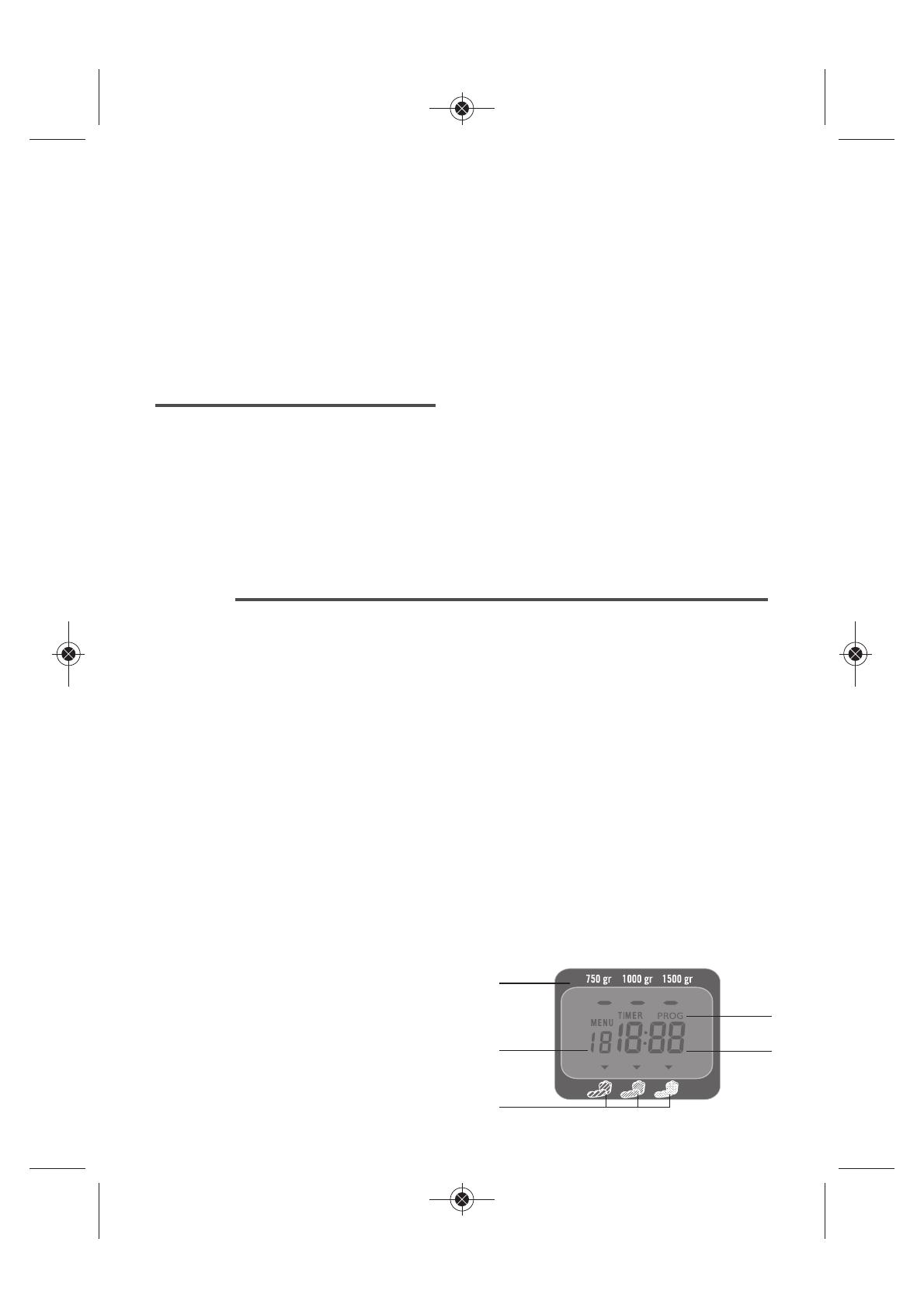
21
• Do not place the baking tray in an oven.
• Never move the appliance while it is in use.
• Do not touch the viewing window during and just after operation. The window can reach
a high temperature.
• Do not place the appliance on other appliances.
• Do not use the appliance as a source of heating.
• Never use the appliance to cook preparations other than bread and jam.
• Do not place paper, card or plastic in the appliance and place nothing on it.
• Should any part of the appliance catch fire, do not attempt to extinguish it with water. Unplug
the appliance. Smother flames with a damp cloth.
• For your safety, only use accessories and spare parts designed for your appliance.
• Never obstruct the air vents.
Electrical supply and power cord
• Make sure that the power it uses corresponds to your electrical supply system. Any error in
connection will cancel the guarantee.
• You appliance must be plugged into an earthed socket. If this is not the case, an electric shock
may be received, possibly causing serious lesions. For your safety, earthing must correspond to
the electrical system standards applicable in your country.
• Do not pull on the supply cord to unplug the appliance.
• Only use an extension lead which is in good condition and which has an earth plug, and ensure
that the lead wire has a cross section at least equal to that supplied with the product.
• The power cord must never be close to or in contact with the hot parts of your appliance, near a
source of heat or over a sharp corner.
Repairs
• Repairs should only be carried out by specialists using original replacement parts. It is dangerous
to try to repair an appliance yourself.
Description
Bread pan
Kneading paddles
Lid with window
Control panel
a. Display screen
a1. Weight indicator
a2. Programme display
a3. Crust colour
a4. Delay start
a5. Timer display
b. Choice of programmes
c. Weight selection
d. Buttons for setting the delayed start
and setting the time for programmes 7
and 15
e. Operating indicator light
f. On/off button
g. Select crust colour
Baking tray
2 non-stick baguette baking trays
2 non-stick trays for individual loaves
1.
2.
3.
4.
5.
6.
7.
Accessories:
Slitter
a. Tablespoon measure
b. Teaspoon measure
Hook for lifting out kneading paddles
Brush
Graduated beaker
8.
9.
10.
11.
12.
4.a5
4.a4
4.a1
4.a2
4.a3
TEFAL393-NoticeBaguette_and_co_Mise en page 1 16/12/09 18:40 Page21
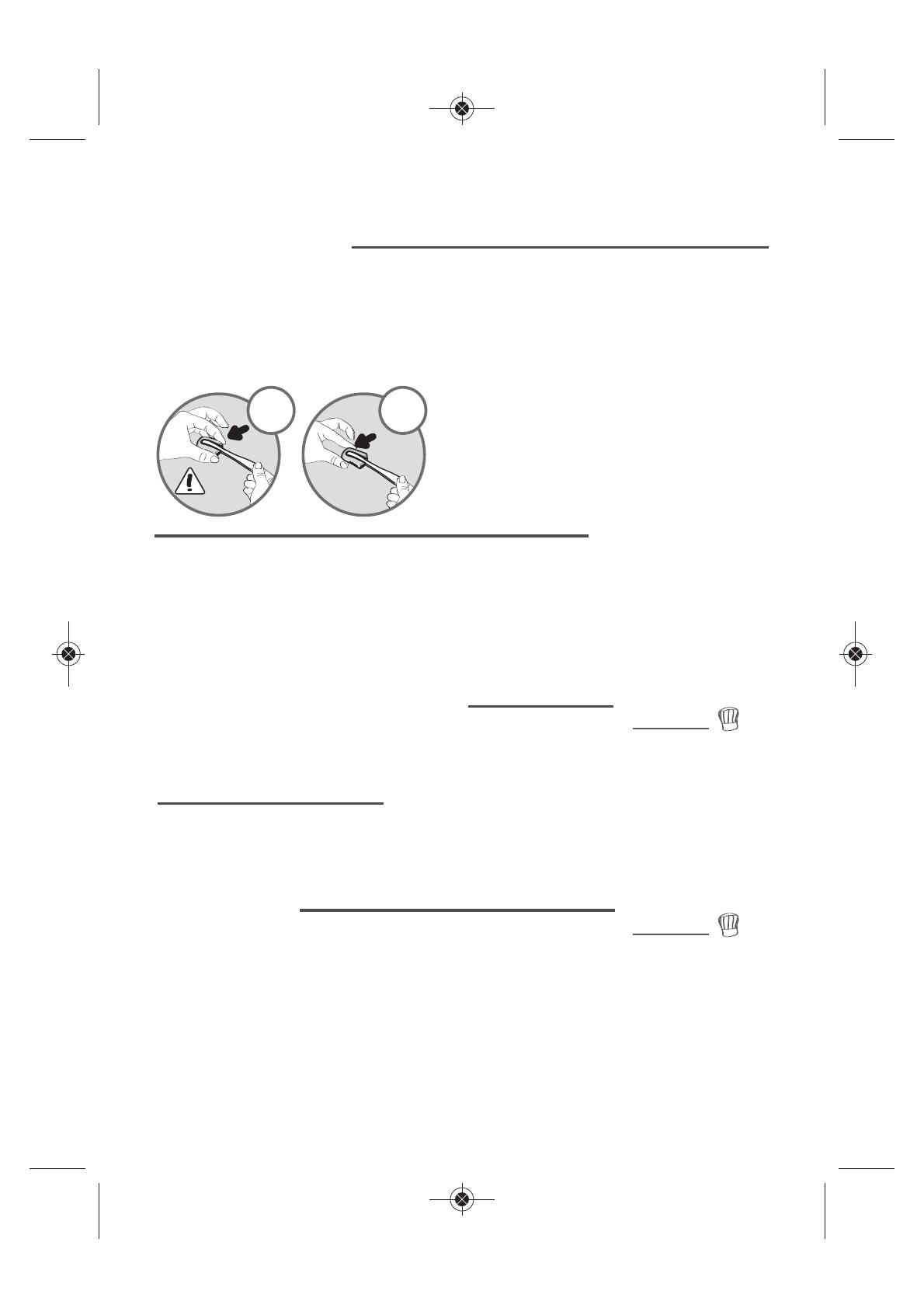
22
Before using for the first time
Remove packaging
• Take your appliance out of its packaging. Keep your warranty card and carefully read the
operating instructions before using your appliance for the first time -
fig. 1
.
• Install your appliance on a stable surface. Remove the accessories and any stickers either inside
or on the outside of the appliance.
Warning
• This scoring tool is very sharp. Handle it with care.
Cleaning the pan
• Clean the pan of the appliance with a damp cloth. Dry thoroughly -
fig. 2
. A slight odour may
be given off when used for the first time.
NO OK
Using
1. Before using your appliance
• Tilt the bread tank slightly to the side then unclip to remove it -
fig. 3
.
• Fit the kneading paddles -
fig. 4
.
2. Add the ingredients
• Put the ingredients in the pan in exactly the order recommended
(see useful tips on page 28) -
fig. 5
.
• Make sure that all ingredients are weighed with precision.
3. Starting up
• Place the bread pan in the breadmaker -
fig. 6
.
• Replace the bread trough and press on one side then the other to
engage the mixer drives and clip it in on both sides -
fig. 7
.
• Unwind the cord and plug it into an earthed electrical outlet.
• After the beep, programme 1 and medium browning are displayed by
default -
fig. 8
.
TIP
The kneading is
improved if the
kneading blades are
set facing each
other.
TIP
To get acquainted
with your
breadmaker, we
suggest you try
the recipe for BASIC
BREAD for your first
ever loaf. See the
sheet “BASIC BREAD
PROGRAMME”
on page 31.
TEFAL393-NoticeBaguette_and_co_Mise en page 1 16/12/09 18:40 Page22
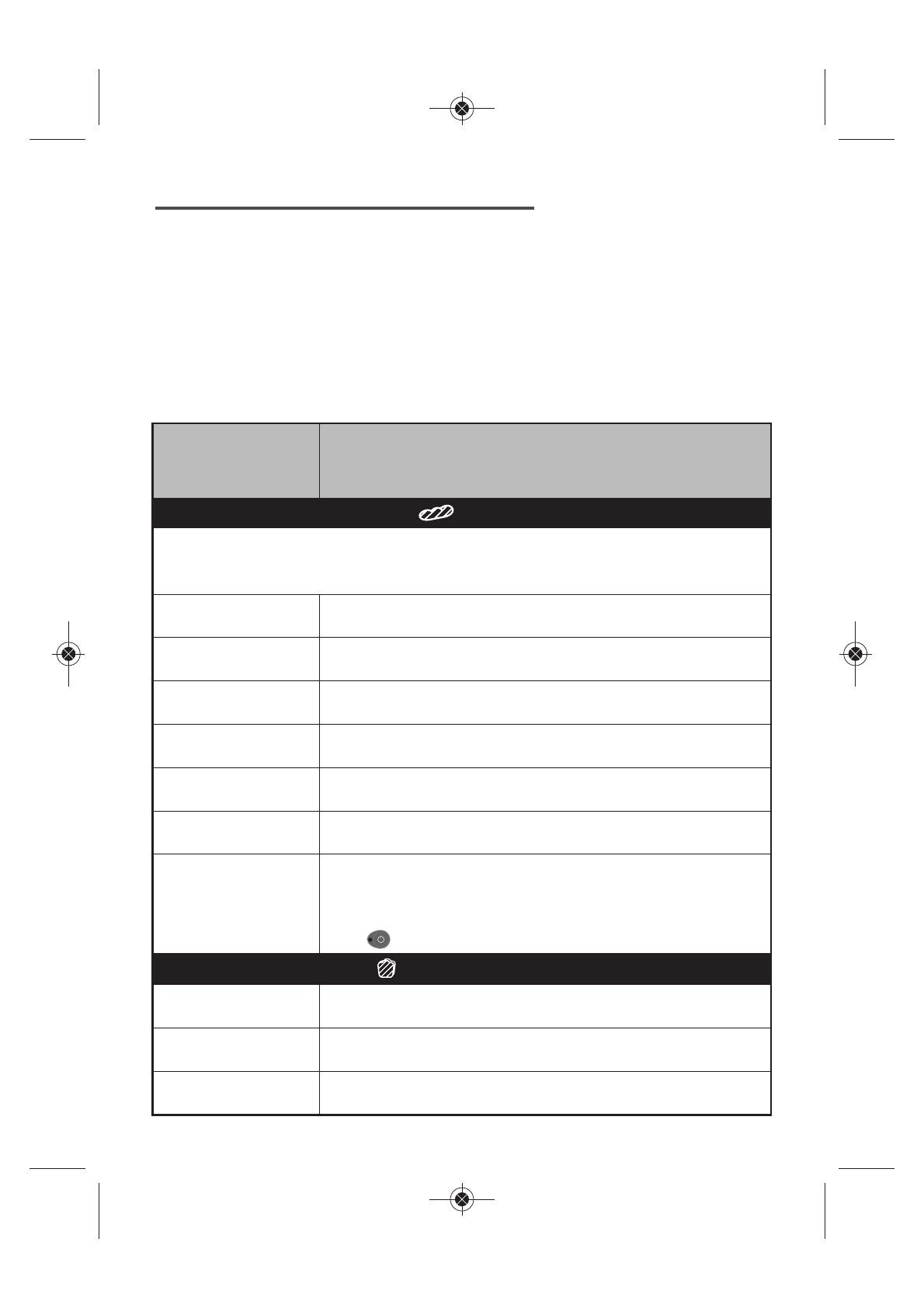
23
4. Select a programme
(See details in the table below)
• A default setting is displayed for each programme. You will therefore have to select the desired
settings manually.
• Choosing a programme triggers a series of steps which are carried out automatically one after
another.
• Press the “menu” button to choose from a variety of different programmes. To scroll through
programmes 1 to 19, successively press the “menu” button.
• The time corresponding to the programme selected is automatically displayed.
PROGRAMMES
AVAILABLE
IN THE MENU
FEATURES
LOAVES
To help you make individual loaves which correspond to programmes 1 to 6, you will find an additional
shaping guide with your breadmaker. These loaves are made in several stages and the baking cycle occurs
after the loaves have been shaped.
1. Savoury Baguettes
& Rolls
The baguette programme allows you to make your own crusty baguettes and
small rolls.
2 . Italian Bread
Programme 2 will help you make Italy's best-known bread, with its soft fluffy
centre, an excellent base for small sandwiches.
3. Bread Sticks
The grissini programme allows you to male these very long, thin and dry
breadsticks.
4. Flat Bread
Programme 4 is designed for making chewy and airy flat breads, such as Pide
(Turkish pita), great for making sandwiches.
5. Burger Buns
Programme 5 is ideal for 8 small white buns, round and soft with a light texture.
6. Sweet Baguettes
& Buns
Programme 6 helps you to make little buns with a light consistency, such as
Spanish ensaimada brioche.
7. Small Bread Cooking
Programme 7 is designed for heating and cooking, in 10 to 35 minutes, all the
loaves made using programmes 1 to 6.
Adjustable in groups of 5 minutes. The breadmaker should not be left
unattended when using programme 7.
To stop the cycle before the end, stop the programme manually by pressing
button for a long time.
TRADITIONAL LOAVES
8. Basic White Bread
This programme allows you to make most white bread recipes using wheat
flour.
9. French Bread
Programme 9 is for traditional French white bread recipes airy in the middle.
10. Wholemeal Bread Programme 10 is selected when using flour for wholemeal bread.
TEFAL393-NoticeBaguette_and_co_Mise en page 1 16/12/09 18:40 Page23
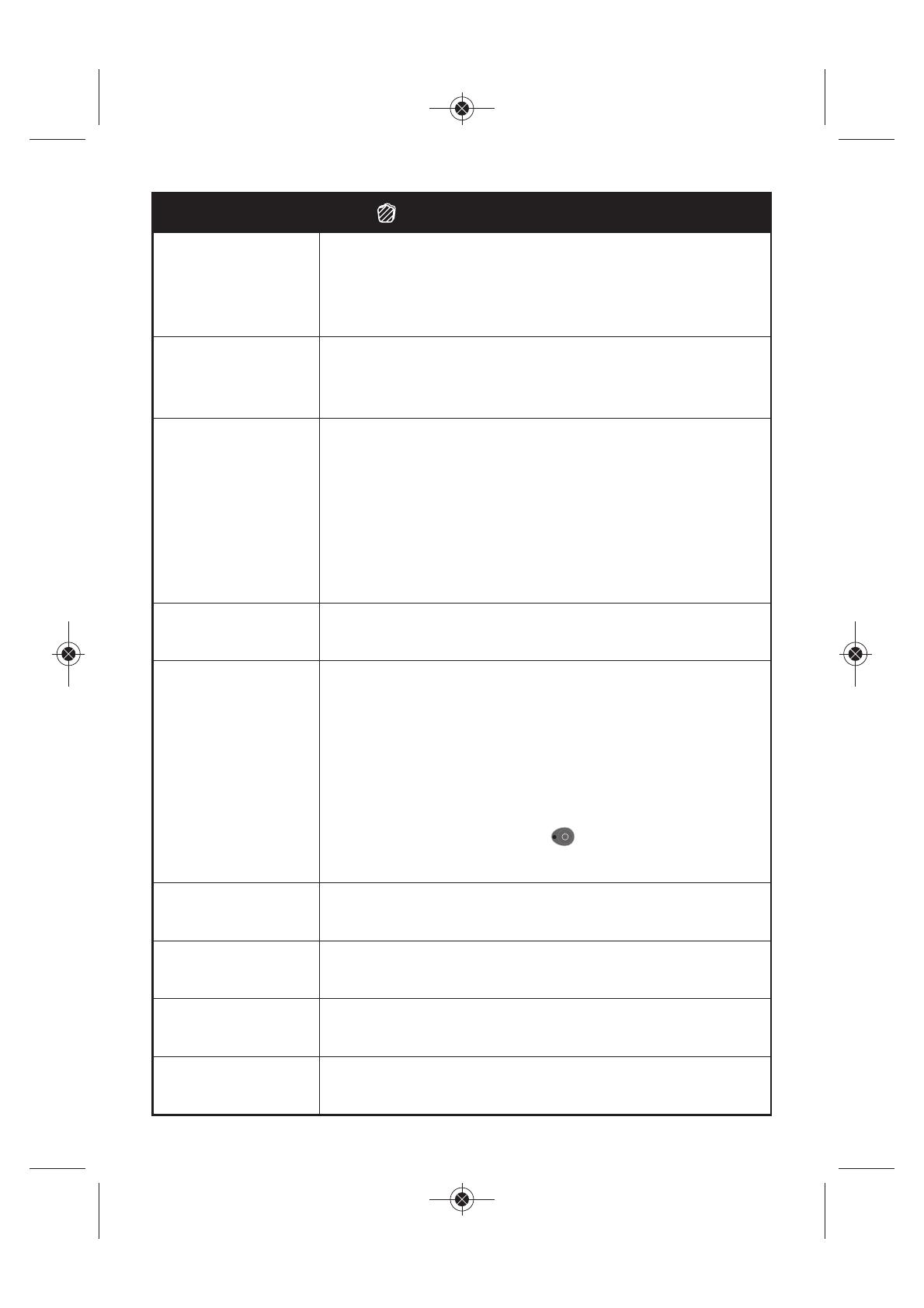
24
TRADITIONAL LOAVES
11. Sweet Bread
Programme 11 is suited to recipes which contain more fat and sugar.
If you use ready made mixes for making brioches or milk loaves, do not exceed
1000 g of dough in total. We suggest LIGHT browning for your first brioche
recipe.
12 . Super Fast White
Bread
Programme 12 is specific to the QUICK bread recipe which you will find in the
recipe book supplied with the appliance. The water for this recipe must be 35°C
maximum.
13. Gluten Free Bread
This kind of bread is suitable for people who cannot digest the gluten
(coeliac disease) in several grains (wheat, barley, rye, oats, kamut, spelt, etc.).
The tank should always be cleaned so that there is no risk of contamination
with other flours. In the case of a strict gluten-free diet, make sure that the
yeast used is also gluten free. The consistency of gluten-free flours means they
do not mix as well. The dough therefore has to be folded in from the edges
during the kneading process with a flexible plastic spatula. Gluten-free bread is
thicker in consistency and lighter in colour than normal bread.
14. Salt Free Bread
Reducing salt consumption can help reduce the risks of cardiovascular
problems.
15. Loaf Cooking
This baking programme enables you to cook for 10 to 70 minutes only,
which time can be adjusted by groups of 10 minutes, for light, medium or dark
browning. It can be selected on its own and used:
a) in association with the raised dough programme,
b) to heat or crisp up bread that has already been cooked and which
has cooled
c) to finish baking in the event of a prolonged power cut during a
baking cycle. This programme cannot be used to bake individual
loaves. The breadmaker should not be left unattended when
using programme 15. To stop the cycle before the end, stop the
programme manually by pressing the button for a long
time.
16. Bread Dough
The Leavened Dough programme does not bake. It is a kneading and rising
programme for all leavened doughs such as pizza dough, rolls, sweet buns.
17. Pasta Dough
Programme 17 only kneads. It is for unleavened pasta, like noodles for example.
18. Cake
Program 18 makes it possible to make pastries and cakes using baking powder.
For this programme, only the 1000 g weight is available.
19. Jam
Programme 19 automatically cooks jam in the tank. The fruit must be roughly
chopped and pitted.
TEFAL393-NoticeBaguette_and_co_Mise en page 1 16/12/09 18:40 Page24

25
5. Selecting the bread weight
• The bread weight is set by default at 1000 g. This weight is shown for informational purposes.
• Refer to the recipe details for more information.
• The setting of the weight is not available for programmes 1 to 7 and 13, 15, 16, 17, 18, 19.
• Press the button to set the chosen product – 750 g, 1000 g or 1500 g -
fig. 9
. The indicator
light against the selected setting comes on.
6. Selecting the crust colour
The crust colour is set to medium by default.
• The browning setting is not available for programmes 7, 15, 16, 17, 19. Three choices are
possible: LIGHT / MEDIUM / DARK.
• If you want to change the default setting, press the button until the indicator light facing the
desired setting comes on -
fig. 10
.
7. Starting a programme
• To start the selected programme, press the button . The operating indicator light comes on
and the 2 dots on the timer start blinking. The programme starts. The time corresponding to the
programme appears. The successive stages automatically follow one another -
fig. 11
.
8. Using the delay start programme
•
You can programme the appliance up to start 15 hours in advance to have your preparation
ready at the time you want.
The delay start programme is not available for programmes 1 to 7 and 12, 13, 15, 16, 17, 18, 19.
This step comes after selecting the programme, browning level and weight. The programme
time is displayed. Calculate the time difference between the moment when you start the
programme and the time at which you want your preparation to be ready. The machine
automatically includes the duration of the programme cycles. Using the and , buttons,
display the calculated time ( up and down). Short presses change the time by intervals of
10 min. Holding the button down gives continuous scrolling of 10-min intervals.
For example: it is 8 pm and you want your bread to be ready for 7 am the next morning.
Programme 11:00 using the and buttons. Press the button. A beep is emitted. PROG is
displayed and the 2 dots on the timer blink. The countdown begins. The ON light switches on.
If you make a mistake or want to change the time setting, hold down the button until it
makes a beep. The default time is displayed. Start the operation again.
With the delayed start programme do not use recipes which contain fresh milk, eggs,
soured cream, yoghurt, cheese or fresh fruit as they could spoil or stale overnight.
9. Stopping a programme
• At the end of the cycle, the programme stops automatically; 0:00 appears - fig. 12. Several
beeps are emitted and the operating indicator light blinks.
• To stop the programme underway or cancel the delayed start, press and hold the button 5 sec.
TEFAL393-NoticeBaguette_and_co_Mise en page 1 16/12/09 18:40 Page25

26
10. Taking your bread out of the pan
(This step does not concern the “individual loaves”)
• Unplug the breadmaker at the end of the cooking or warming cycle.
• Tilt the bread tank slightly to the side then unclip to remove it. Always use oven gloves as the pan
handle is hot, as is the inside of the lid -
fig. 13.
• Turn out the hot bread and place it on a rack for at least 1 hour to cool -
fig. 14.
• It may happen that the kneading paddles remain stuck in the loaf when it is turned out.
In this case, use the hook accessory as follows:
> once the loaf is turned out, lay it on its side while still hot and hold it down with one hand,
wearing an oven glove,
> with the other hand, insert the hook in the axis of the kneading paddle and pull gently to release
the kneading paddle -
fig. 15,
> repeat for the second kneading paddle,
> turn the loaf upright and stand on a grid to cool.
• To preserve the pan’s non-stick qualities, do not use metallic utensils to turn out the bread.
Cleaning and maintenance
• Unplug the device and leave it to cool with the lid open.
• Remove the lid, if you need to turn the product over.
• Clean the outside and inside of the appliance with a damp sponge. Dry carefully.
• Wash the tank, the mixing blades, the baking tray and the non-stick plates with hot soapy water.
• If the kneading blades stay in the mixing bowl, soak for 5 to 10 minutes.
• If necessary, remove the lid to clean it with hot water -
fig. 16.
• Do not wash any part in a dishwasher -
fig. 17.
• Do not use household cleaning products, scouring pads or alcohol. Use a soft, damp cloth.
• Never immerse the body of the appliance or the lid.
• Do not store the baking tray and the non-stick plates in the bread machine as this could scratch
its coating.
Cycles
• A table on the next page describes the breakdown of the various programme cycles.
Kneading
For forming
the dough’s
structure so
that it can rise
better.
Rest
Allows the
dough to rest
to improve
kneading
quality.
Rising
Time during
which the yeast
works to let the
bread rise and
to develop its
aroma.
Baking
Transforms
the dough
into bread
and gives it
a golden,
crusty crust.
Warming
Keeps the bread
warm after baking.
It is recommende
that the bread
should be turned out
promptly after
baking, however.
>
> > >
Kneading: the dough is in the 1
st
or 2
nd
kneading cycle or in a stirring period
between rising cycles.
See the summary table of preparation times below and in particular the
column “Time displayed at the ingredients signal”. This column gives the
time displayed on the screen of your device when the beeps are heard. In
order to establish more precisely after how long the beeps will be heard,
you simply need to subtract the time in the “time displayed at the
ingredients signal” column from the total baking time.
E.g.: “Time displayed at the ingredients signal” = 2:51 and “Total Time” =
3:13, the ingredients can be added after 22 min.
TIP
During this cycle,
except for
programmes 7, 13,
15, 16, 17, 19,
you can add
ingredients: dried
fruit, olives, bacon
bits, etc. A series of
TEFAL393-NoticeBaguette_and_co_Mise en page 1 16/12/09 18:40 Page26

27
Rising: the dough is in the 1
st
, 2
nd
or 3
rd
rising cycle.
Baking: the bread is in the final baking cycle.
Warming: for programmes 8, 9, 10, 11, 12, 13, 14, 18, you can leave your
preparation in the appliance. A one-hour warming cycle automatically
follows baking.
The display remains at 0:00 during keeping warm hour. The operating
indicator light flashes. A beep is heard at regular intervals.
At the end of the cycle the appliance stops automatically and beeps several
times.
beeps tell you when
you can add them.
Do not put more
additives than is
indicated in the
recipe, and make
sure they do not
fall outside the
baking tray or the
bowl.
Note: total time does not include the keep hot time.
Programmes
Weight
(g)
Total
programme
time
(h)
Dough
preparation
time
(kneading-
resting-rising)
Baking 1
(h)
Baking 2
(h)
Time
displayed
at the
ingredients
signal (h)
Keeping
warm
(h)
1 - 2:39 1:10 0:47 0:42 2:19 -
2 - 2:30 1:20 0:35 0:35 2:10 -
3 - 2:24 1:20 0:32 0:32 2:06 -
4 - 1:25 0:35 0:25 0:25 1:12 -
5 - 2:30 1:20 0:40 0:30 2:15 -
6 - 2:52 1:25 0:47 0:40 2:34 -
7 -
10 to 35 min,
in 5 min
increments
-
10 to
35 min
- - -
8
750 3:12
2:17
0:55 - 2:54
1:001000 3:17 1:00 - 2:59
1500 3:22 1:05 - 3:04
9
750 3:19
2:24
0:55 - 3:03
1:001000 3:24 1:00 - 3:08
1500 3:29 1:05 - 3:13
10
750 3:17
2:12
1:05 - 2:59
1:001000 3:22 1:10 - 3:04
1500 3:27 1:15 - 3:09
11
750 3:15
2:15
1:00 - 2:51
1:001000 3:20 1:05 - 2:56
1500 3:25 1:10 - 3:01
12
750 1:30
0:35
0:55 - 1:23
1:001000 1:35 1:00 - 1:28
1500 1:40 1:05 - 1:33
13 1000 1:42 0:47 0:55 - - 1:00
14
750 2:41
1:41
1:00 - 2:23
1:001000 2:46 1:05 - 2:28
1500 2:51 1:10 - 2:33
15 -
10 to 70 min,
in 10 min
increments
-
10 to
70 min
- - -
16 - 1:25 1:25 0:00 - - -
17 - 0:15 0:15 0:00 - - -
18 1000 1:29 0:09 1:20 - 1:23 1:00
19 - 1:05 0:15 0:50 - - -
LOAVESTRADITIONAL LOAVES
TEFAL393-NoticeBaguette_and_co_Mise en page 1 16/12/09 18:40 Page27

28
Pratical advice
Preparing the recipes
• All ingredients used must be at room temperature (unless otherwise indicated) and must be
weighed exactly.
Measure liquids with the graduated beaker supplied. Measure liquids with the graduated
beaker supplied. Use the double doser supplied to measure teaspoons on one side and
tablespoons on the other. All spoon measures are level and not heaped. Incorrect
measurements give bad results.
• Follow the preparation order.
> Liquids (butter, oil, eggs, water, milk)
> Salt
> Sugar
> Flour, first half
> Powdered milk
> Specific solid ingredients
> Flour, second half
> Yeast
• It is important to measure the quantity of flour precisely. That is why you should weigh out flour
using a kitchen scale. Use packets of flaked dried yeast (sold in the Uk as Easy Bake or Fast Action
Yeast). Unless otherwise indicated in the recipe, do not use baking powder.
Once a packet of yeast has been opened, it should be sealed, stored in a cool place and used
within 48 hours.
• To avoid spoiling the proving of the dough, we advise that all ingredients should be put in the
bread pan at the start and that you should avoid opening the lid during use (unless otherwise
indicated). Carefully follow the order of ingredients and quantities indicated in the recipes.
First the liquids, then the solids. Yeast should not come into contact with liquids, sugar or
salt.
• Bread preparation is very sensitive to temperature and humidity conditions. In case of
high heat, use liquids that are cooler than usual. Likewise, if it is cold, it may be necessary to warm
up the water or milk (never exceeding 35°C).
• It can also sometimes be useful to check the state of the dough during the second
kneading: it should form an even ball which comes away easily from the walls of the pan.
> if not all of the flour has been blended into the dough, add a little more water,
> if the dough is too wet and sticks to the sides, you may need to add a little flour.
Such corrections should be undertaken very gradually (no more than 1 tablespoon at a time) and
wait to see if there is an improvement before continuing.
• A common error is to think that adding more yeast will make the bread rise more. Too
much yeast makes the structure of the bread more fragile and it will rise a lot and then fall while
baking. You can determine the state of the dough just before baking by touching it lightly with
your fingertips: the dough should be slightly resistant and the fingerprint should disappear little
by little.
• When shaping the dough, do not work it for too long because you may not get the expected
result after cooking.
Using your bread machine
• If there is a power cut: if, during the cycle, the programme is interrupted by a power cut or
mishandling, the machine has a 7-min protection time during which the settings are saved. The
cycle starts again where it stopped. Beyond that time, the settings are lost.
• If you do make two loaves in succession with the traditional Loaf programme, wait 1 hour
before starting the second loaf. Otherwise the error code E01 is displayed.
TEFAL393-NoticeBaguette_and_co_Mise en page 1 16/12/09 18:40 Page28

29
Preparation and production of individual loaves
The steps below are common to all individual loaves: programme from 1 to 6.
1
st
stage: Kneading and rising of the dough
• Press the “menu” button and choose the
desired programme.
• Select the crust colour.
• Press button . The operating light comes on and the 2 timer dots start blinking -
fig. 18
.
• The dough kneading cycle starts up, followed by the rising cycle. These 2 steps will be carried out
automatically.
• During the kneading stage, it is normal for the dough not to be evenly blended.
• When the preparation is complete, the breadmaker goes into sleep mode for 1 H. Several beeps
indicate that the kneading and rising of the dough have ended. The time remaining is displayed
and operating indicator light flashes -
fig. 19
.
• Remove the bowl from the machine -
fig. 20
.
• After the dough kneading and rising stages, you must use your dough within an hour of
hearing the beeps. Beyond that, the machine resets and the programme is lost. In this
case, we recommend that you use programme 7 which is the programme for baking
individual loaves.
2
nd
stage: Production of individual loaves
To help you through those steps, refer to the baguette shaping
guide supplied. We are showing you what a baker does, but
after a few trials, you will be able to create your own shapes.
Whatever you do, the result is guaranteed.
• Sprinkle a little flour on your work surface.
• Remove the dough from the pan and put it on your work surface.
IMPORTANT The length obtained for the various loaves
should match the size of the non-stick plate
(about 18 cm).
• Once the loaves have been shaped, place them on the non-stick
plates and then on the baking tray.
TIP
To garnish loaves with
seeds, wrap them in a
damp cloth (or a paper
towel) and then roll
them in the seeds.
TIP
For lighter bread, leave
the uncooked loaves to
rise for five minutes
before shaping them.
1
2
TEFAL393-NoticeBaguette_and_co_Mise en page 1 16/12/09 18:40 Page29

30
3
rd
stage: Baking - 1
st
Cycle
• Place the baking tray inside the breadmaker, in place of the tank.
• Press the button again to restart the programme and start baking
the bread.
• At the end of the 1
st
baking cycle, the machine goes into sleep mode for
30 min. Several beeps are emitted and the operating indicator light blinks.
• Remove the baking tray. Always use oven gloves because the tray is very
hot.
• Remove the loaves from the plates and leave them to cool on a wire
cooling rack.
Programmes of 1 to 6 are designed to carry out 2 successive bakings. However, if you only
want to bake once, you must stop the machine manually by pressing for a long time.
Baking - 2
nd
Cycle
• Leave the lid open so that the machine can
cool down sufficiently before starting the 2
nd
round of baking.
• Arrange the remaining loaves on the non-
stick plates and then on to the baking tray.
Place inside the machine.
• Press the button to start the second
baking cycle.
• At the end of the cycle, the programme stops automatically. Several
beeps are emitted and the operating indicator light blinks. Unplug the
breadmaker.
• Remove the baking tray. Always use oven gloves because the tray is
very hot.
• Remove the loaves from the non-stick plates and leave them to cool on
a wire cooling rack.
TIP
Run the plates under
cold water (to
cool them down) and
dry them before
using them for the
2
nd
baking operation.
TEFAL393-NoticeBaguette_and_co_Mise en page 1 16/12/09 18:40 Page30

31
1. RECIPES FOR TRADITIONAL LOAVES
Basic White Bread (programme 8)
tsp > Teaspoon - tbsp > Tablespoon
The recipes
Guide for improving your conventional bread recipes
Crust colour > Medium
Weight > 1000 g
Time > 3 : 17
Oil > 2 tbsp
Water > 350 ml
Salt > 2 tsp
Sugar > 2 tbsp
Powdered milk > 2,5 tbsp
White bread flour > 600 g
Yeast > 1,5 tsp
Ingredients
IMPORTANT Using the same principle you can make other traditional loaves:
French bread, brown bread, sweet bread, quick bread, gluten-free bread, salt-
free bread; to do so, simply select the corresponding programme using the
menu button.
The bread hasn't
turned out as you
hoped? This table
should help you to
improve things
RESULTS
Bread rises
too much
Bread falls
after rising
too much
Bread does
not rise
enough
Crust not
golden
enough
Sides brown
but bread
not fully
cooked
Top
and sides
floury
POSSIBLE CAUSES
The button was
pressed during baking
Not enough flour
Too much flour
Not enough yeast
Too much yeast
Not enough water
Too much water
Not enough sugar
Poor quality flour
Wrong proportions
of ingredients
(too much)
Water too hot
Water too cold
Wrong programme
TEFAL393-NoticeBaguette_and_co_Mise en page 1 16/12/09 18:40 Page31
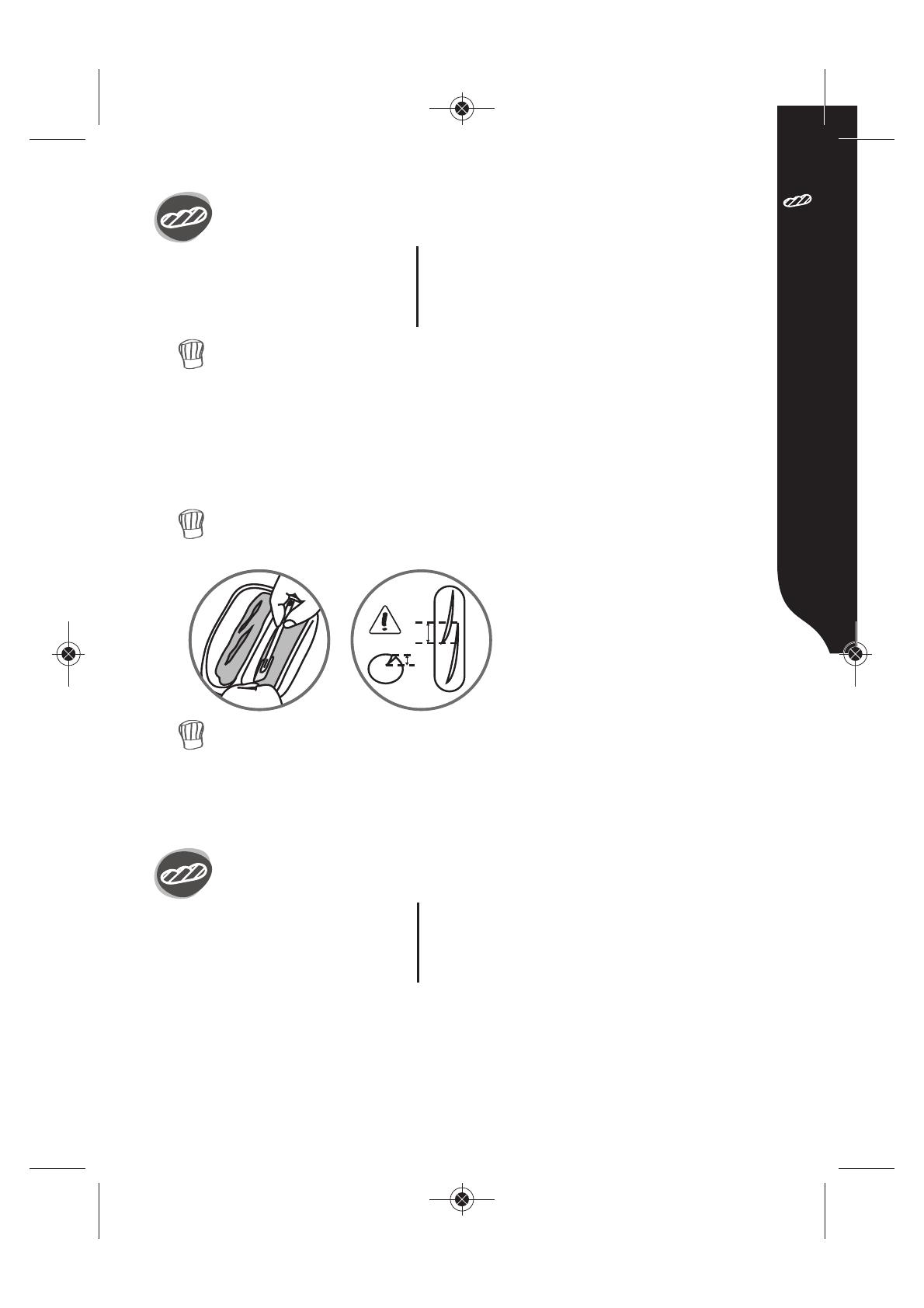
32
2. RECIPES FOR INDIVIDUAL LOAVES
Savoury Baguettes & Rolls (programme 1): for 8 80 g baguettes
tsp > Teaspoon - tbsp > Tablespoon
Water > 255 ml
Salt > 1½ tsp
T55 flour > 420 g
Dried yeast > 2 tsp
Ingredients
1 baking tray (5)
2 non-stick baguette plates (6)
1 scorer (8)
1 brush (11)
Accessories
To make your baguettes even softer, add one tbsp of oil to your recipe. If you
want to give more colour to your baguettes, add 2 tsp of sugar to your
ingredients.
1
st
stage
The 2 stages, the kneading and rising of the dough, are carried out automatically
and last a total of 1 h 10 (25 min of kneading followed by 45 min. for the rising
of the dough).
2
nd
stage
Begin to shape 4 dough pieces and cover the 4 other dough pieces with a cloth
or clingfilm.
You can vary the flavours by garnishing your bread. To do this, simply moisten
and then roll the dough pieces in sesame or poppy seeds.
For best results, score a 1 cm diagonal
slit across the baguettes using a
serrated knife or the supplied scorer.
You can vary the presentation of your baguettes by scoring slits along the
length of the baguette.
3
rd
stage
With the kitchen brush provided, generously moisten the top of the baguettes,
taking care not to get too much water on the non-stick trays.
IMPORTANT The seam of the baguettes must be underneath.
2cm
1cm
Italian Bread (programme 2): for 4 ciabattas
tsp > Teaspoon - tbsp > Tablespoon
Water > 360 ml
Salt > 2 tsp
T55 flour > 500 g
Dried yeast > 2 tsp
Ingredients
1 baking tray (5)
2 non-stick trays for individual loaves (7)
1 brush (11)
Accessories
1
st
stage
The 2 stages, the kneading and rising of the dough, are carried out automatically
and last a total of 1 h 20 (25 min. of kneading followed by 55 min. for the rising
of the dough).
2
nd
stage
Begin to shape 2 dough pieces and cover the 2 other dough pieces with a cloth
or clingfilm.
3
rd
stage
With the kitchen brush, spread a little olive oil over the ciabatta.
TEFAL393-NoticeBaguette_and_co_Mise en page 1 16/12/09 18:40 Page32

33
2. RECIPES FOR INDIVIDUAL LOAVES
Bread Sticks (programme 3): for 20 grissini
tsp > Teaspoon - tbsp > Tablespoon
Water > 125 ml
Salt > ½ tsp
Olive oil > 2 tsp
T55 flour > 210 g
Dried yeast > 1 tsp
This recipe cannot be made
with smaller quantities.
Ingredients
1 baking tray (5)
2 non-stick trays for individual loaves (7)
1 brush (11)
Accessories
1
st
stage
The 2 stages, the kneading and rising of the dough, are carried out automatically
and last a total of 1 h 20 (30 min of kneading followed by 50 min. for the dough
to rise).
2
nd
stage
Begin to shape 10 grissini and cover the 10 other grissini with a cloth or clingfilm.
To prevent the breadsticks from breaking, stretch them out in 2 stages.
Flat Bread (programme 4): for 4 flat loaves
tsp > Teaspoon - tbsp > Tablespoon
T55 flour > 250 g
Salt > ½ tsp
Water > 150 g
Dried yeast> 2 tsp
Dough ingredients
Cold water > ¼ cup
Flour > ¼ cup
Very hot water > ½ cup
Ingrédients “barbouille”
1 baking tray (5)
2 non-stick trays
for individual loaves (7)
1 brush (11)
Accessories
1
st
stage
The 2 stages, the kneading and rising of the dough, are carried out automatically
and last a total of 35 min (20 min of kneading followed by 15 min. for the dough
to rise).
2
nd
stage
Begin to shape 2 dough pieces and cover the 2 other dough pieces with a cloth
or clingfilm.
3
rd
stage
Prepare the “glaze” by mixing together cold water and flour. Then add very hot
water to this mixture. Spread the “glaze” over the loaves with your hands. Do not
use all of the mixture.
For more crusty loaves, replace the
“glaze” with an egg yolk that you can
spread using the brush. Then press
with your fingertips around the edges
of the loaves.
TEFAL393-NoticeBaguette_and_co_Mise en page 1 16/12/09 18:40 Page33
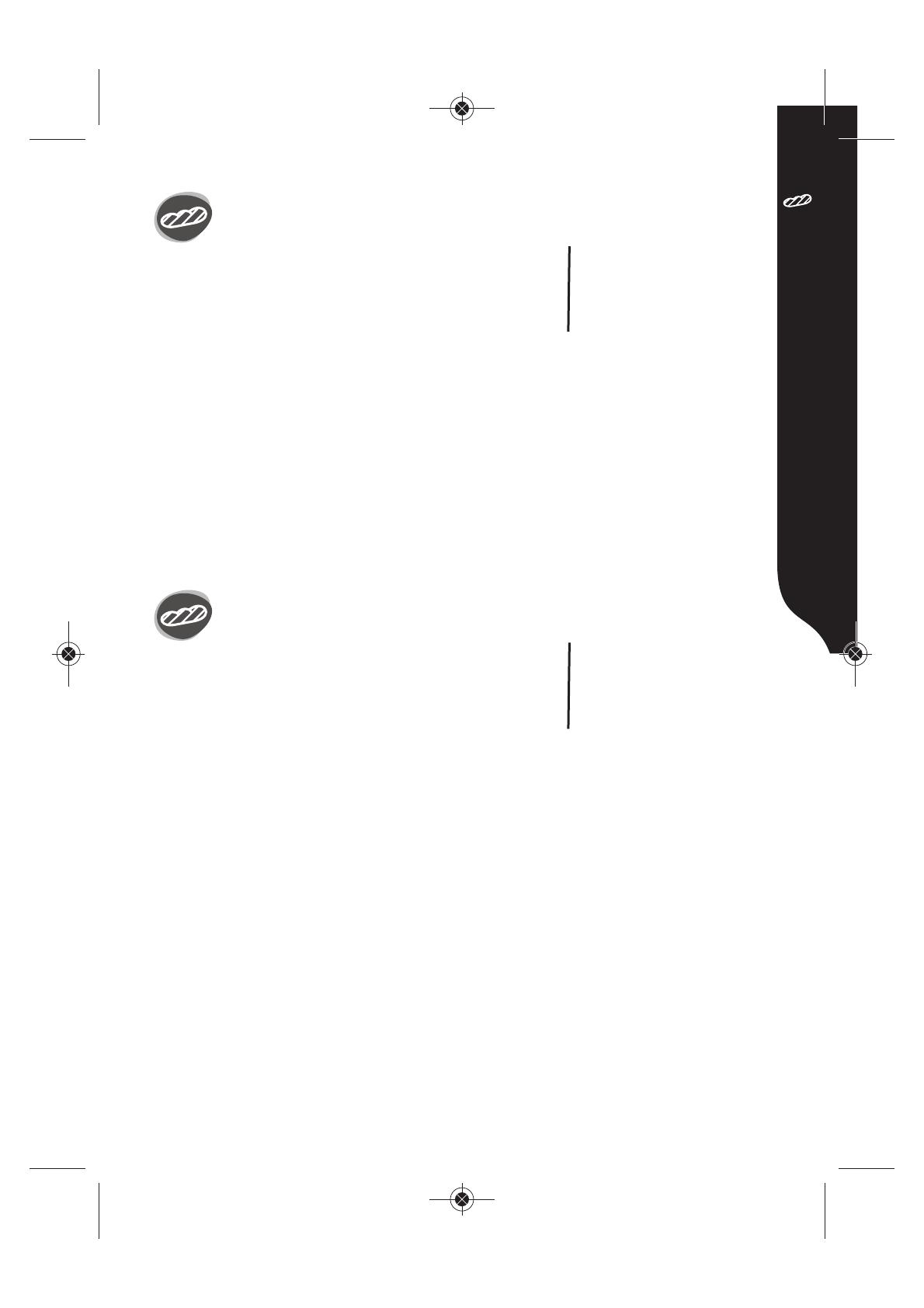
34
2. RECIPES FOR INDIVIDUAL LOAVES
Burger Buns (programme 5): for 8 sandwich loaves
tsp > Teaspoon - tbsp > Tablespoon
Water > 215 ml
Milk powder > 10 g
Oil > 3 tsp
Salt > 1 tspn
Ingredients
Sugar > 2.5 tsp
T55 flour > 360 g
Dried yeast > 2 tsp
1 baking tray (5)
2 non-stick trays for individual
loaves for individual loaves (7)
1 brush (11)
Accessories
1
st
stage
The 2 stages, the kneading and rising of the dough, are carried out automatically
and last a total of 1 h 20 (25 min of kneading followed by 55 min. for the dough
to rise.
2
nd
stage
Begin to shape 4 dough pieces and cover the other 4 dough pieces with a cloth
or clingfilm.
3
rd
stage
Once they are placed on the trays, and to keep the round shape, flatten
the dough pieces lightly with the palm of your hand to prevent them from
rising too much.
Sweet Baguettes & Buns (programme 6): for 8 small buns
tsp > Teaspoon - tbsp > Tablespoon
Egg > 1
Milk > 110 ml
Oil > 2.5 tsp
Butter > 65 g
Ingredients
Salt > 1 tsp
Sugar > 4.5 tsp
T55 flour > 300 g
Dried yeast > 2 tsp
1 baking tray (5)
2 non-stick trays
for individual loaves (7)
1 brush (11)
Accessories
1
st
stage
The 2 stages, the kneading and rising of the dough are carried out automatically
and last (30 min. of kneading followed by 55 min. for the dough to rise).
2
nd
stage
Begin to shape 4 dough pieces and cover the other 4 dough pieces with a cloth
or clingfilm.
3
rd
stage
To give a shiny appearance, use the brush to brush with a mixture of egg and
water, in equal proportions.
TEFAL393-NoticeBaguette_and_co_Mise en page 1 16/12/09 18:40 Page34
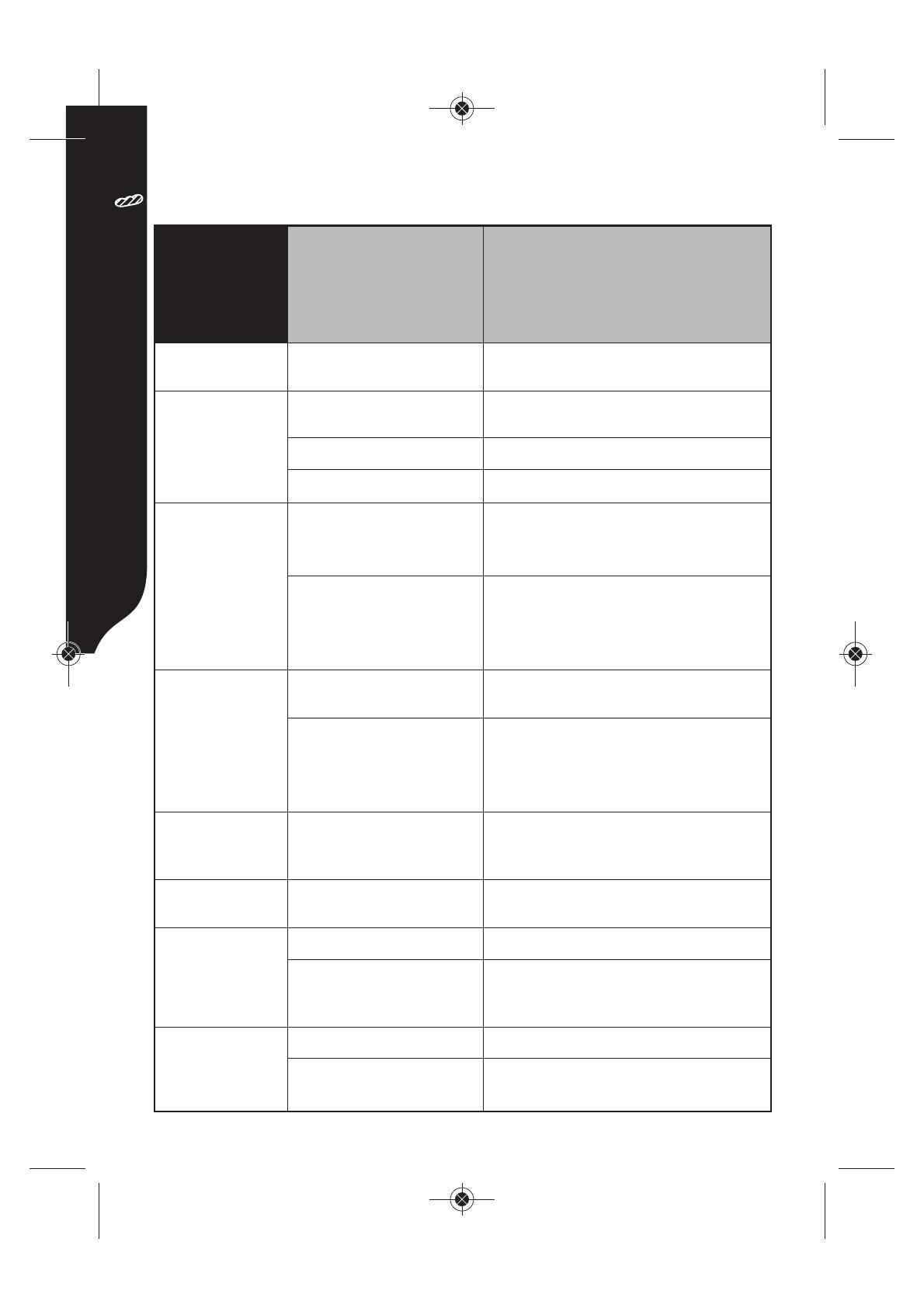
35
The bread hasn't
turned out as you
hoped? This table
should help you to
improve things
POSSIBLE CAUSE SOLUTION
The dough is sticky.
There is too much water in the
mixture.
- Reduce the amount of water.
- Flour your hands before shaping the dough.
The dough tears
easily.
The flour does not have enough
gluten.
- Choose a pastry flour (T 45).
The dough is too hard. - Leave to rest for 10 mn before shaping.
The shapes are irregular.
- Weigh the dough pieces to ensure they are the
same size.
The dough is
compact.
There is too much flour in the
mixture.
- Pre-shape roughly and leave to rest before the
final shaping.
- Add a little water at the beginning of the
kneading.
The dough is overworked.
- Leave to rest for 10 mn before shaping.
- Flour the work surface as little as possible.
- Shape by working the dough as little as possible.
The buns touch and
are not baked
enough.
Badly positioned on the plates.
- Space the dough pieces when arranging them
on the plates.
Dough too runny.
- Measure all liquid carefully
- Recipes designed for eggs of 50 g, if the eggs
are bigger reduce the amount of water by as
much.
The buns stick to the
plate and are burnt.
Too much browning.
- Choose a lower browning setting.
- Ensure the browning does not run onto the
plate.
The buns are
dull after baking.
Lack of moisture at the start of
baking.
- Use the brush to apply a glaze of egg and water
before baking.
The buns have
not risen enough.
Not enough yeast. - Use more yeast.
Dough has been overworked.
- Leave to rest for 10 mn before shaping.
- Shape the dough by working it as little as possible.
The buns have
risen too much.
Too much yeast. - Use less yeast.
Risen too much.
- Flatten the loaves slightly once they are placed
on the plates.
Guide for improving your individual loaf recipes
2. RECIPES FOR INDIVIDUAL LOAVES
TEFAL393-NoticeBaguette_and_co_Mise en page 1 16/12/09 18:40 Page35
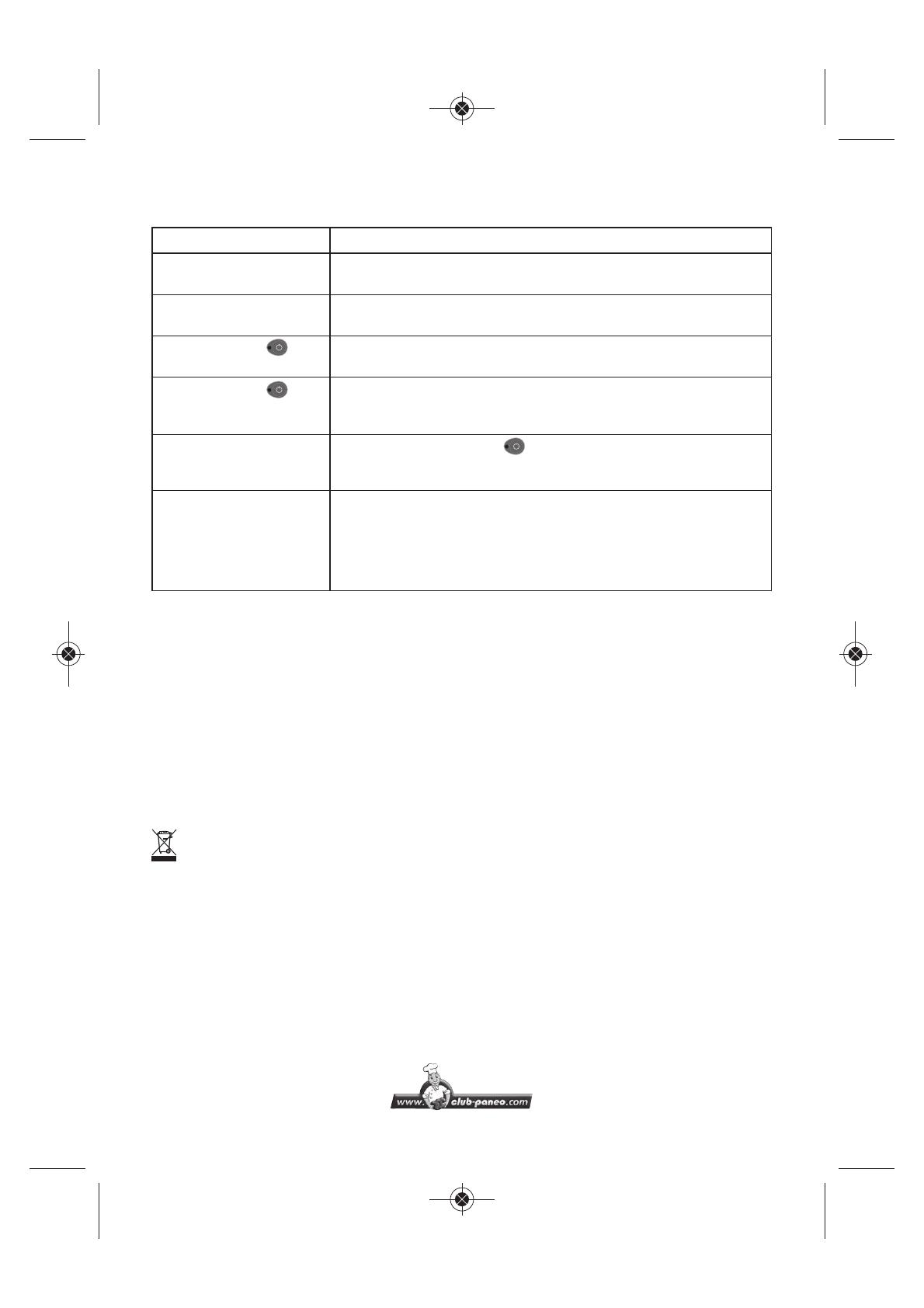
36
For a detailed video on the shaping of the baguettes,
download the filmed instructions
on the following internet site:
Technical troubleshooting guide
Warranty
Environment
PROBLEMS
The kneading paddles remain
stuck in the bread trough.
• Let it soak before removing it.
The kneading paddles
remain stuck in the loaf.
• Use the accessory to turn out the loaf (page 26).
After pressing on
nothing happens.
• The machine is too hot. Wait 1 hour between 2 cycles.
• A delayed start has been programmed.
After pressing on the
motor is on but no
kneading takes place.
• The pan has not been correctly inserted.
• Kneading paddle missing or not installed properly.
After a delayed start, the
bread has not risen enough
or nothing happens.
• You forgot to press on after programming.
• The yeast has come into contact with salt and/or water.
• Kneading paddle missing.
Burnt smell. • Some of the ingredients have fallen outside the pan: let the
machine cool down and clean the inside of the machine with a
damp sponge and without any cleaning product.
• The preparation has overflowed: the quantity of ingredients used
is too great, notably liquid. Follow the proportions given in the
recipe.
SOLUTIONS
• This product has been designed for domestic use only. Any professional use, innapropriate use or
failure to comply with the instructions, the manufacturer accepts no responsibility and the
guarantee will not apply.
• Read the instructions for use carefully before using your appliance for the first time: any use
which does not conform to these instructions will absolve Tefal from any liability.
• In accordance with current regulations, before disposing of an appliance no longer needed, the
appliance must be rendered inoperative (by unplugging it and cutting off the supply cord).
Environment protection first!
!
Your appliance contains valuable materials which can be recovered or recycled.
! Leave it at a local civic waste collection point.
TEFAL393-NoticeBaguette_and_co_Mise en page 1 16/12/09 18:40 Page36
/